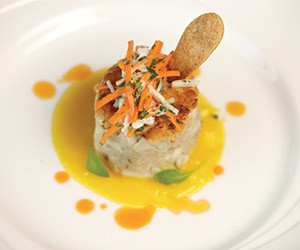To stay on the cutting edge, chefs in hotels, resorts and independent eateries have to keep up with what’s on people’s minds—and palates. Following are observations from a sampling of Florida’s top chefs, whose stock-in-trade is keeping up with today’s trends.
Healthy Bites
Chef Antonio Estremera of The Grove Resort in Orlando sees more and more influences from Italy, Spain and France, and the continued focus on creating healthy dishes, including an increase in gluten-free options.
“As such, super foods like quinoa and chia are more commonly finding a way into kitchens across the United States,” he said.
The hotel has a selection of indoor venues that range from an intimate boardroom with seating for 20 to a spacious ballroom for nearly 250. Alfresco affairs will find a home poolside at one of the resort’s four swimming pools, or on The Grove’s lush lawn or garden area, all amid a backdrop of natural marsh, wooded landscape and lakeside views.
Healthier food choices are also on the menu at the Hammock Beach Resort in Palm Coast, such as rice cakes instead of toast, almond and soymilk with kasha, gluten-free options, and bran instead of sugary cereals.
“We have added flaxseed, goji berries and chia seeds as a topping for stone-ground oatmeal to add a boost to the metabolism,” said Jonathan Christian, executive sous chef, Hammock Beach. Lunch at Hammock Beach is ideally suited for those who want healthier options, too, with gluten-free and multigrain breads as a standard and not just available on request. Meanwhile, dinner options incorporate ancient grains, such as faro, quinoa and bulgur wheat, as well as sustainable fish. Signature dishes include sustainable grilled cobia with red and yellow peppers, topped with mango relish and cilantro oil.
The hotel offers a host of potential indoor/outdoor private dining spaces for groups, from traditional ballrooms to the intimate Sushi Bar and the Cigar Bar, to the comfort of the resort’s luxury villas and suites equipped with full eat-in kitchens. The outdoor event lawns with ocean views and private fire pits are also perfect for group events.
Seagar’s Prime Steaks & Seafood at the Hilton Sandestin Beach Golf Resort & Spa, Miramar Beach focuses on local and sustainable products and experiments with the use of local honey.
“Although we are a traditional New York-style steak house, we also feature fresh fish and seafood from the waters just outside our doors,” said Executive Chef Laurie Graupner. “We have a partnership with a local farm in the area, which is where our delicious pork belly and fresh produce come from.”
The semi-private Wine Room, which can accommodate up to six guests, features the largest concentration of fine wines on Florida’s Emerald Coast. The Tapestry can seat up to 10 guests in a semi-private alcove while the restaurant’s pianist serenades them. Perfect for VIPs or corporate guests, the Boardroom holds up to 16 people, while the Florida Room seats up to 40 guests. The entire restaurant is also available for functions.
One of the newest restaurants to arrive at Walt Disney World’s Disney Springs in Orlando is Homecoming Florida Kitchen, owned by two-time James Beard Award-winning chef and native Floridian Art Smith. He acknowledges that his guests are mindful about the origins of their food. The restaurant uses locally sourced ingredients when possible and also pays homage to Florida agriculture.
“We even have a wall with a rotating exhibit that showcases Florida farmers who are contributing to the state’s economy and eco-diversity,” Smith said.
Groups visiting the restaurant can use the front patio and screened-in porch for up to 60, or the entire restaurant can be rented for larger groups.
Portion Control
In a trend toward eating less at meetings, the shiny chafing buffet dishes are out and small plates are in, according to chef Robert Ash of the Omni Orlando Resort at ChampionsGate.
“Guests are more conscious of what they are eating today,” Ash said. “They want transparency and smaller portions. Overly fried or food dripping in heavy cream and butter sauces is so passe; guests crave a mouthful of textures and seek foods that are vibrant.”
One exception? Guests don’t want their foods “screaming healthy,” Ash said, as it could simply lack of flavor.
One 2016 trend Ash sees losing its superstar superfood status is kale.
“Goodbye kale, hello kelp and seaweed. Seaweed in its many shapes and forms is back on the forefront,” he said.
Known for its health benefits and accessibility, items like seaweed and kelp are used in sweet and savory dishes, as well as in beverages, he said, though they must be used in a non-obtrusive, subtle manner.
“We want to garner the flavor and health benefits while enhancing the dish, not overpowering it,” he said.
The property offers private dining areas for small groups within Trevi’s and Zen restaurants.
Similarly, the “food as medicine” trend has taken hold in people’s personal lives and is now finding its way into more requests for group meal functions, said Nando Belmonte, complex executive chef, Loews Sapphire Falls Resort at Universal Orlando and Loews Royal Pacific Resort at Universal Orlando.
“This includes, in particular, more requests for non-meat entrees and instead putting veggies at the center of the plate,” Belmonte said. “We have even accommodated requests for fermented food and drinks since many people are mindful of the importance of probiotics in their diet. We also incorporated turmeric into dishes, as it is known to have natural, anti-inflammatory medicinal properties.”
One of the areas popular for group events at Loews Sapphire Falls Resort is Cayman Court, an outdoor, covered event area adjacent to the meeting space.
Growing Your Own Omni’s Ash noted another intriguing trend: More and more chefs are hijacking plots of land on hotel rooftops, or even on the walls of restaurants, to plant and harvest crops.
“Depending on the footprint chefs have to work with, creative spaces like an on-site storage pod are even being used,” he said. “At Omni we utilize both outdoor space and indoor wall spaces for growing lettuces and herbs, and our plans are to expand our chef farm space in time.”
At Omni Amelia Island Plantation Resort, the recently introduced Sprouting Project includes a garden, greenhouse and barrel room for private dinners. Groups can tour Omni Amelia Island Plantation’s state-of-the-art aquaponic greenhouse, expansive organic garden and large collection of beehives before enjoying a plated dinner that incorporates items harvested directly from the Sprouting Project.
At the Orange County Convention Center in Orlando, Centerplate, the center’s in-house caterer, recently debuted the OCCC Vision Gardens, the largest aeroponic garden in a public venue in the country. It currently produces 780 plants a week (40,000 per year), providing greens, chards, bok choy, celery, herbs and micro-greens utilized in the center’s catered meals prepared by Centerplate’s culinary team, which is led by “Chef K” James Katurakes.
Nobu Eden Roc Hotel Executive Chef Thomas Buckley said he is seeing a lot of excitement around Malibu Farm opening this spring at the South Beach hotel.
“Malibu Farm embodies this farm-to-table movement and really embraces the concept; it’s more than just a trend but really about embracing it as a lifestyle,” Buckley explained.
Growing your own is akin to catching your own, said Executive Chef Ricky Gopeesingh, Sinclair’s Ocean Grill at Jupiter Beach Resort & Spa.
“Now more than ever, groups are seeking experiential meetings where they can dive into a destination and its local culture,” he said. “We offer a hands-on experience that gives groups an opportunity to go fishing, and then create an unforgettable dining experience. There’s nothing better than fishing for fresh catch with your toes in the sand while watching the waves roll in.”
Waste Not
Another trend chefs are embracing is producing less waste, according to John Drugan, director of food and beverage for the Ponte Vedra Inn & Club, who calls the hotel’s policy “Head to Tail and Root to Leaf.”
“We use the whole animal to create innovative flavor-packed dishes across different stations,” he noted. “In 2017 we will see this trend grow in plant and vegetable usage as well. We’ll look for innovative uses for root stocks and not-normally-used plant by-products, like radish-top pesto.”
The property offers the Seafoam Dining Room with oceanfront windows, the Inn Dining Room, the Surf Club Patio and the Ocean Deck Grille.
Chef Daven Wardynski of Omni Amelia Island Plantation is on board with saving food: 2017 is the year of trash, he said.
“Well, not so much trash, but utilization of the excess food that we typically throw away,” he explained. “Items like broccoli stems previously discarded are now finding new life used in crisp slaws. Wilted and imperfect outer leaves of romaine lettuce are dehydrated and burned to make a sweet romaine ash that accents the subtle flavors in their Atlantic Ocean pompano.”
Leftover wine from the hotel’s group catering is poured into a 20-liter reclaimed tequila barrel, stuffed with Georgia peaches and vinegar, then placed into a 36-barrel aging room buried in the earth.
In three to six months of fermentation, the process yields what Chef Wardynski said “is the most amazing peach vinegar you have ever tasted. This speaks to our commitment to consistently challenging what we do as chefs and how we are always searching for ways to improve our guest experience. It should never be good enough.”
Now there’s a trendsetter.




